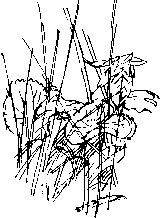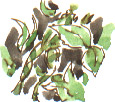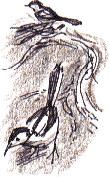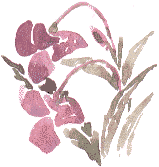 |
'Tree Frogs'Thursday 2nd August 2001, West Yorkshire |
![]()
![]()
![]()
![]()
![]()
![]() This Month
Rocks
History
Workshop
Links
Home Page
This Month
Rocks
History
Workshop
Links
Home Page
![]()

 IN NEED of more practice so I sit down again to sketch the vegetation by the pond. These are leaves of Kingcups. I notice a movement in the Kilmarnock willow bush that overhangs the pond. On a leaf about 18 inches above the pond a Frog shuffles forward and sits supported by the leaves and twigs. It's not alone, another takes position just below it.
IN NEED of more practice so I sit down again to sketch the vegetation by the pond. These are leaves of Kingcups. I notice a movement in the Kilmarnock willow bush that overhangs the pond. On a leaf about 18 inches above the pond a Frog shuffles forward and sits supported by the leaves and twigs. It's not alone, another takes position just below it.This is behaviour that I've noticed only once before, years ago when I watched a frog hop across the lawn, jump up to the herb bed and climb up into the
 Cotoneaster bush. From the purposeful way it took up its position, I assumed that this was a regular part of its hunting territory. Needless to say it's more normal to find frogs amongst vegetation or, of course, in the pond.
Cotoneaster bush. From the purposeful way it took up its position, I assumed that this was a regular part of its hunting territory. Needless to say it's more normal to find frogs amongst vegetation or, of course, in the pond.I don't get far with my sketch because midge-like insects are landing in hair and on my ears, despite a dousing of citronella. But the insect rush hour is no doubt the reason that frogs have positioned in the bush at this time of evening.
By the way, that phrase 'insect rush hour' comes from an article on spiders and their extraordinary uses of silk, in this month's National Geographic, Deadly Silk by Richard Conniff.
Island Succession
 When I started writing this diary three years ago, I often found myself referring to some wagtail or moorhen I'd seen on a bar of silt at the side of the river. I called it 'silt island'. Once a family of swans used to rest there.
When I started writing this diary three years ago, I often found myself referring to some wagtail or moorhen I'd seen on a bar of silt at the side of the river. I called it 'silt island'. Once a family of swans used to rest there.By last year the bare silt was well covered by vegetation, notably Reed Grass, Pharlaris, which I often think of by its nickname 'Canal Grass'.
 This summer it's more like a tropical desert island, with a dense stand of Himalayan Balsam, an introduced plant that seems to be able to cope well with exposed mud, even in places that are polluted.
This summer it's more like a tropical desert island, with a dense stand of Himalayan Balsam, an introduced plant that seems to be able to cope well with exposed mud, even in places that are polluted.
Related Link
At the time of writing spiders feature on the National Geographic Website.![]()
Richard Bell,
wildlife illustrator
E-mail; 'richard@willowisland.co.uk'
![]() Next page
Previous page
This day last year
This month
Nature Diary
Home Page
Next page
Previous page
This day last year
This month
Nature Diary
Home Page
![]()